While similar in size to its sister model, the JBL L100 Classic, the 4312G is produced as a mirror-imaged pair of speakers. This means that its offset driver layout will allow some different options when it comes to getting them properly set up in a room.
JBL 4312G Loudspeaker
- Sold as mirror-imaged pairs.
- They can be oriented either vertically or horizontally like some professional monitors.
- Tweeters can be oriented (vertically) on the inside or outside, depending on the room.
- Capable of good imaging and solid bass performance.
- Big soundstage with a good sense of depth when in the sweet spot.
- Front-mounted controls for tailoring midrange and treble response.
Secrets Sponsor
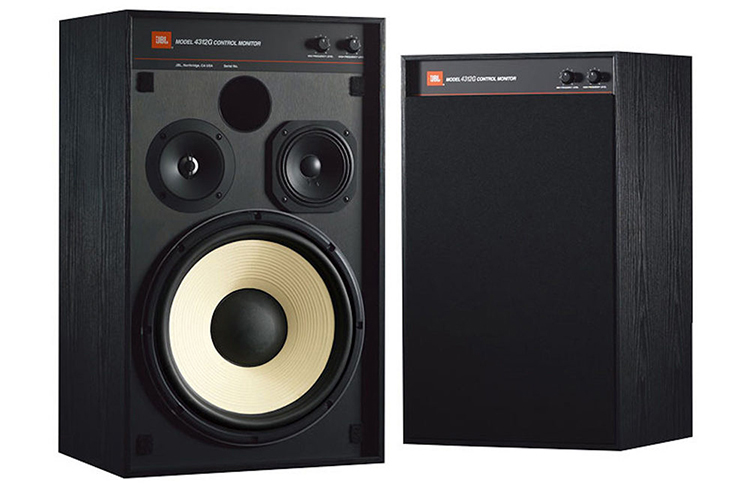
In the last few years, JBL has been going “back to the well” so to speak and drawing inspiration from its history, both pro and home, when designing new speakers that will entice today’s consumers. Whereas a year earlier, JBL announced the L100 Classics (themselves based on the L100 Century home speaker), CES 2019 saw JBL take the wraps off the 4312G. The JBL 4312G is principally inspired by the 4310 family of professional studio monitors that came into prominence during the early 1970s. By the middle of that decade, the 4310 had become one of JBL’s most successful professional products commonly being found in recording studios all over the United States and abroad.

The new JBL 4312G is more specifically modeled after the 4311 control monitor (an evolution of the 4310), having the identical driver and port layout along with the tweeter and midrange tailoring controls. Using thoroughly modern driver and crossover technology along with today’s construction techniques, can the qualities that made those studio monitors of old popular be translated into a more modern framework? And, frankly speaking, is the 4312G more than just a simple nostalgia play to appeal to guys like me or to younger generations who seem to relish a more retro sort of experience? There’s no better time than now to have a look!
Description:
3-way Bass Reflex Bookshelf Loudspeaker with front-firing port
High-Frequency Driver:
Single 1” Magnesium/Aluminum alloy dome tweeter with waveguide
Mid-Frequency Driver:
Single 5” polymer-coated pure pulp cone
Low-Frequency Driver:
Single 12” pure pulp cone woofer
Frequency Response:
(-6dB): 44Hz – 40kHz (Manufacturer)
Crossover Frequencies:
640Hz, 5kHz
Nominal Impedance:
6 Ohms
Sensitivity:
90 dB (2.83 Volts @ 1 Meter
Recommended Amplifier Power:
10 – 200 Watts
Available Finishes:
Black Woodgrain with Black Cloth Grille
Dimensions:
(H x W x D): 23.5 x 14.25 x 12 inches (597 x 362 x 305mm)
Net weight:
52.4 lbs (23.8kg) each
MSRP:
$2,500.00 (pair)
Company:
SECRETS Tags:
jbl, synthesis, speakers, bookshelf, 4312g
After pulling the JBL 4312G out of their shipping boxes and stepping back to get a good look at them, I was instantly reminded of the big multi-driver speakers that were commonplace in homes and Hi-Fi shops during my youth in the 1970s and early 80s. All those speakers back then were trying their hardest to look very serious, their designs no doubt aping professional studio loudspeakers of the day. In the JBL 4312G we come full circle and are presented with a design that is directly based on the old JBL 4311 professional control monitor that found favor in many production studios in the 1970s.
In a similar fashion, as was done with JBL’s recent L100 Classic speaker, the 4312G takes the classic look and design of its inspiration and updates it with modern drivers, crossovers and construction know-how.
In pretty much mirroring the driver layout of the old 4311, the 4312G starts with a 2 and ¾” wide port at the top. Right below that we have a 1” Magnesium/Aluminum alloy dome tweeter within a waveguide sitting next to a 5” polymer-coated pure-pulp-cone midrange driver.
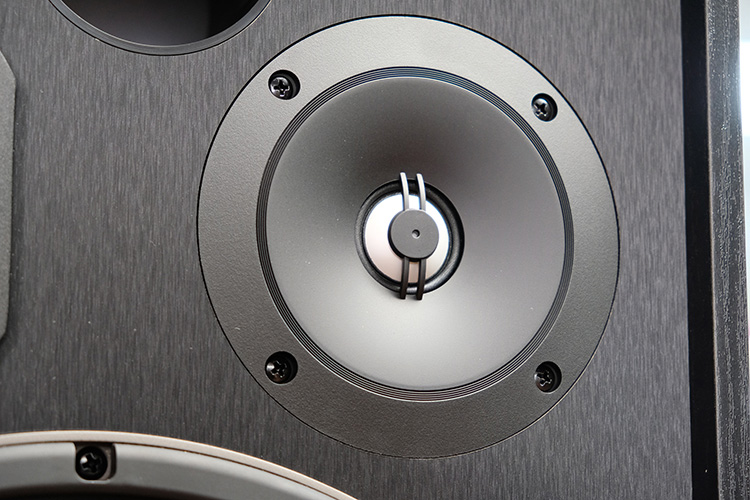
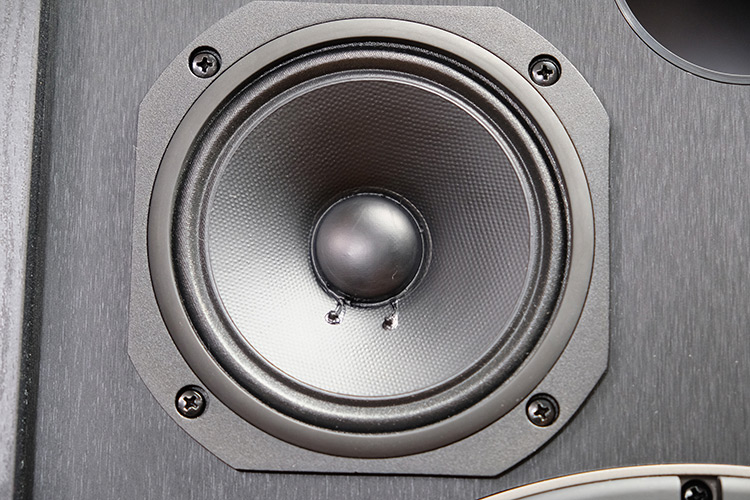
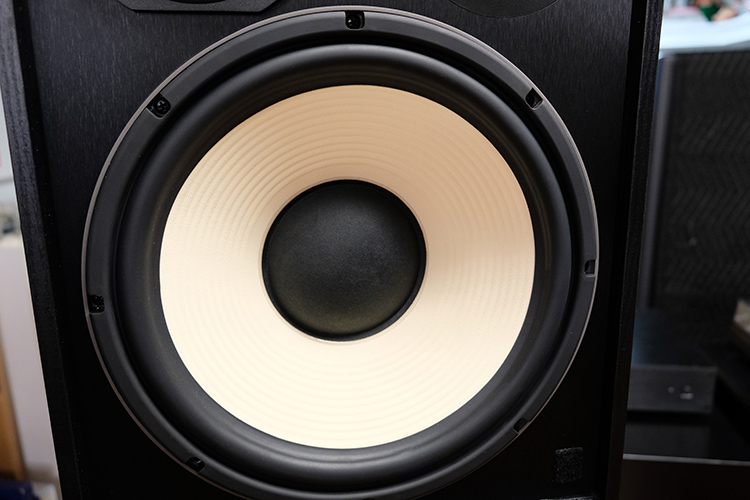
Below the tweeter and midrange driver is a hefty looking 12” pure pulp woofer with that classic looking white cone. Since the tweeter and midrange drivers are offset in their orientation (as opposed to being vertically in line with each other) the JBL 4312G is sold in mirror-imaged pairs. This also allows the speakers to be oriented either vertically or horizontally depending on what yields the best response in a given room, very much like in a pro studio situation.
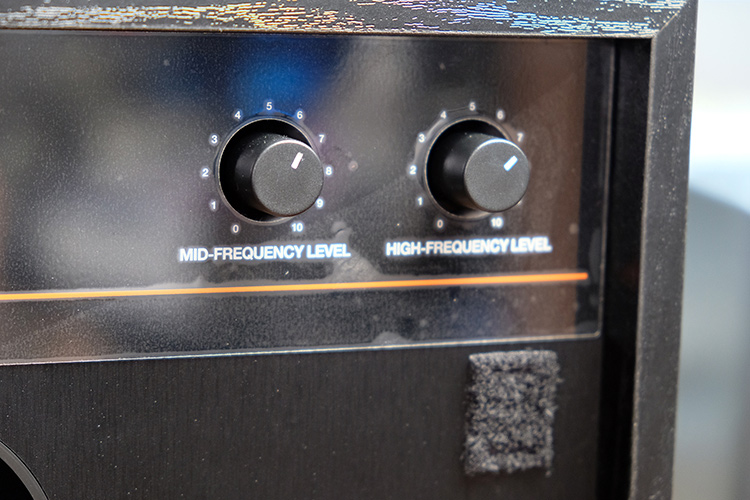
At the very top of the front baffle, there are two rotary dials. One allows fine adjustments to the mid-range driver level while the other does the same for the tweeter. Both dials are labeled from 0 to 10 and, according to the manual, the number 5 position (found at 12 o’clock on the dials) is considered the default “neutral” setting. After some experimentation and listening, I set the dials on the 6 position for the midrange drivers and the 6.5 position for the tweeters.
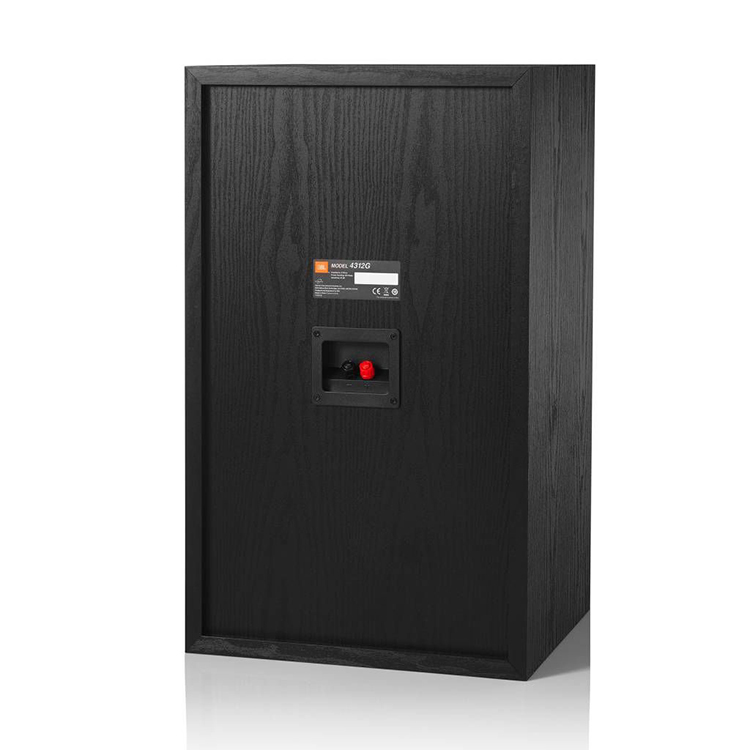
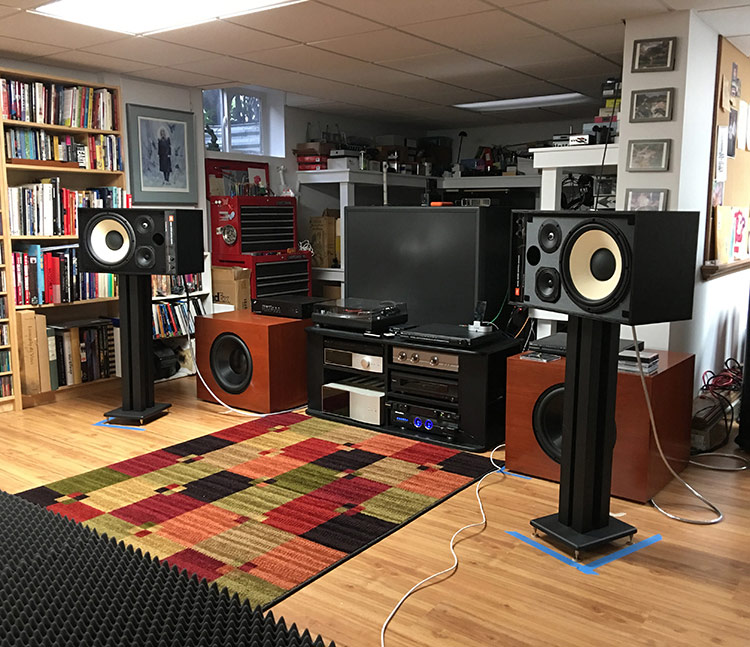
When the JBL 4312G speakers arrived, I set them up in my studio listening area positioned about 9-feet apart on stands and toed-in at about a 10-degree angle, as this is how I customarily start off. My seating position was also just under 9-feet away from either speaker. After some tweaking, the speakers ended up being re-oriented onto their sides with the tweeter/mid array on the inside and the woofer on the outside. An OPPO BDP-105D Universal Player served as the main source (using both discs and a hard drive full of FLAC and DSD files) while the ELAC Alchemy DDP-2 preamp (review in progress) and the Anthem STR power amp completed the audio chain. Occasionally, I would swap the STR amp for an ELAC Alchemy DPA-2 power amp (also in for review). For a vinyl source, I used my Technics SL1200 Mk 6 modified by KAB Electroacoustic, along with an Audio Technica OC9ML/II Moving Coil phono cartridge. This was hooked up to the ELAC PPA-2 Phono preamp. Speaker and interconnect cables were from Blue Jeans Cables.
Secrets Sponsor
I’m just going to come right out and say that these are a very fun pair of speakers to listen to and that I personally find them to be very appealing on a few different levels.
From a sonic standpoint, the sideways orientation that I settled on for these speakers resulted in rather precise imaging and a fairly wide and deep soundstage when seated in the main listening position. This did, however, come at the expense of a noticeable drop in off-axis performance when listening casually, seated further afield. When I was in the money-seat though, the JBL 4312G did not do much to disappoint. To my ears, these speakers had a good, balanced handling of the midrange and upper frequencies with just a bit of extra emphasis on the vocal region of the spectrum. I kept feeling like I was getting a little more forward presentation with some of my favorite jazz and blues performers. They seemed to stand out just a little bit more with these JBLs. Not in a jarring way, mind you, but just enough that they gave a little extra body and sparkle to those voices. Treble was also very well managed with these speakers. The little trim knobs proved very helpful in dialing in the high frequencies right to my liking. While these JBLs may not have the same level of upper-end transparency as what I heard from the Revel F228Be that I just had here previously (granted, perhaps a slightly unfair comparison) or my Salk Songtowers (much closer in price), the 4312G did acquit themselves well to strings, flutes and brass without ever becoming annoying or fatiguing. The bass impact from those 12-inch woofers was also very solid. Even when perched on my tall-ish 32-inch stands, the JBLs made me feel those kick drums when hey hit hard and acoustic double-bass sounded particularly weighty and tuneful. On a side note, I found myself listening to a lot of vinyl on this review. Something about the JBL’s sound just made me want to dig through my records and sample them on these speakers. The results were consistently favorable and it made for a great time listening to a large array of material that I haven’t dug out in a while.
Of course, there may have been more at play here than just the sound that was giving me the “warm & fuzzies” with these speakers. The overall look of the JBL 4312G was bringing on a healthy dose of nostalgia to these eyes. Memories came flooding back of similar-looking speakers from various Toronto Hi-Fi shops where I spent an inordinate amount of my time as a youth. The 4312G also looked like miniature versions of the monster-sized StudioLab speakers my college friend’s dad had in their rec-room so many years ago. We listened to tons of Pink Floyd, Genesis and Rush on those beasts and a very similar fondness returns to me when I turn up the volume on these JBLs. While I can’t say with any degree of certainty that these sound anywhere near the same as those speakers of old, they most certainly sound good by today’s standards. And I expect they can’t help but be a big improvement over the original inspiration models from the 70s. But I do believe that, beyond the sound of these speakers, the look is meant to appeal to people like me for example who have strong formative memories and emotions that are tied to this style of speaker. Very “Analog” memories if you will. Conversely, I can also see the appeal of the JBL 4312G to a younger music buyer for whom the “retro” look and cred carries a large draw. And that’s a large demographic these days. I cite for you my perpetually-device-connected teenage boys who just thought the look and sound of these speakers were fantastic. My 18-year-old has a turntable and listens to vinyl regularly. He loves vintage stuff and was all over these JBLs when he played some of his metal LPs through them. My 16-year-old is into modern pop and dance music. He just bought his first non-downloaded album and was it a CD? No, it was vinyl. Vinyl!? Yep, and he was all over the look and sound of these JBLs too.
The following are a few notable musical selections that I felt showed off the JBL 4312G during my time with them:

About as analog of a modern-day recording as you are likely to find. The rear jacket of the LP mentions how 3M and Ampex tape machines were used along with Neumann, RCA, and Electrovoice microphones in the session recordings.
The whole album sounds and feels like not just an homage to R&B music from the late 50s and 60s but a fresh extension, with enough modern sensibilities to make it live and breath as a current statement. Ironically, very much like these JBLs! Right from the get-go, the first track “By Heart” leads off with fantastic-sounding double-bass plucks that are at once both meaty sounding and granular in detail through the JBLs. The skin sound of the drum hits come through with great snap and character. Waterhouse’s voice is firmly planted in the center of the image and is easily intelligible.The classic rich twang of his Gretsch guitar filling out the center-left of the soundstage showcased how well the 4312Gs handled the collective pitch, distortion, and reverberation in those guitar notes. These good sounding throwback vibes continue on Waterhouse’s cover of “I Feel an Urge Coming On”, from 1968, and the slower-paced “Undedicated”. The latter tune throwing out a particularly huge, reverberant image that frames the accompanying, almost boogie-woogie style saxophone work. The sax itself sounds almost palpable with the JBLs rendering all its energy and detail in great style. “Which Was Writ” is a more intimate sounding, shuffle-paced tune that is just dripping with cool. The bass-line is driving this song with a thick and punchy groove and Waterhouse’s vocals sound like they are right in front of me. “Thought & Act” is another slow, moody and atmospheric standout track with the delicacy of the guitar playing and haunting flute solo being the attention getters here. The JBL’s reproduced this album like it’s “old-hat,” and they made it shine.
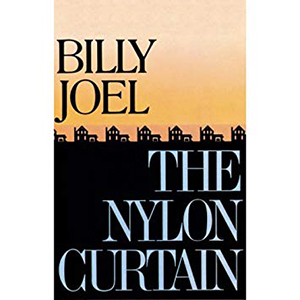
A staple from my middle school years and an early digital recording, The Nylon Curtain holds up really well as one of Billy Joel’s best creative works. While “Allentown”, “Goodnight Saigon” and “Pressure” are the songs that everyone remembers from this album, all the other tracks are musical and emotional gems in their own right. “Laura” is a case in point.
There are late-era Beatles influences throughout the sound of this track with the JBLs doing an admirable job recreating the many layers of multiple instrumentations including strings, bass, guitars, and keyboards. Liberty DeVito’s drum work is right out front and sounds tight yet powerful. Joel’s anguished vocals are also dead center and clear as a bell. “She’s Right On Time” continues with the multi-layered instrumental approach but Joel takes a more soulful tack with his singing. All the musical details are nicely laid out and the JBL’s push out such a huge image for the bulk of this song that it sounds like a proper stadium event as opposed to a studio recording. On “Surprises” Joel channels his inner John Lennon with the vocal delivery, sounding the most etherial and Beatle-esq of all the songs on this album. The vinyl has a certain warmness to this tune in particular that my CD copy of this album lacks. That warmness certainly came across and worked well with the sound of the 4312G, and again the drums on this track sounded so impactful through these speakers.

A well-produced modern jazz recording that I heard at RMAF and quickly snapped up a copy. In what seems to be a common thread in this review, this 2015 recording was captured on 24-track, 2-inch analog tape and the SACD was mastered from ½-inch analog tape.
The liner notes also claim that Ms. Stanley’s vocals were recorded at Capitol Recording Studios through the same Neumann U-47 microphone that Frank Sinatra used back in the day. All that was old is truly new again it seems! Regardless of the techniques used, this recording is certainly a standout and sounded great on the retro-themed JBLs. On “Just One of Those Things,” Ms. Stanley’s voice floats in space well in front of the speakers and is nicely delineated. I mentioned earlier that I felt the 4312Gs gave a little bit of added prominence to vocals, flattering them in a sense, and that was certainly happening on this album. Her voice was up close and personal but not in an unpleasant way. In other news, the bass line was easy to follow and had a nice weight to it and the trombone solo midway through the song was smooth and had a lovely tone. The goodness continued on “More Than You Know” with the accompanying piano sounding especially clear with a great ring to the notes through the JBLs. “Boulevard of Broken Dreams” sports a nicely composed arrangement of cello, harmonica, piano, and varied percussion. The JBLs place everything, precisely ordered, around Stanley’s full and clean vocal delivery. The harmonica solo is handled very sweetly by these speakers, no irritation at all, and the cello playing had great string detail and a full tonality to it too.
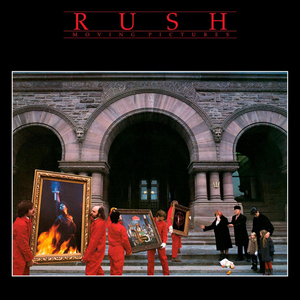
Ah yes, a little classic Canadiana in the form of one of Rush’s most enduring albums. Reliving several hours of my misspent youth here, it was only right and proper to sample Moving Pictures with the 4312G and they delivered handily. The opening strains of “Tom Sawyer” with the synthesizer intro and Neil Pert’s punchy kick drum brought back a ton of memories.
Geddy Lee’s opening vocals sounded clear and nicely centered with Alex Lifeson’s distorted guitar hooks sounding properly thick and crunchy. During the section when all three members are soloing simultaneously, the JBL’s handle the electric bass, guitar, and drums parts weaving all around each other deftly like a perfect acoustic storm. “YYZ” is a very much a classic instrumental jam with three virtuoso musicians. Along with a fairly big soundstage, there is much fast-paced musical interplay here that the JBL’s keep nicely sorted while rendering each instrument to sound as it should. Nothing gets lost or sounds mushy and every instrument is easy to follow. “Limelight” is probably one of my favorite Rush songs and, like the rest of this album, sounds perfectly right to me on these speakers. The bass and drums have what seems like an almost unending amount of drive, the 4312G imbuing each with a great level of impact. Within that, the electric guitar whines and wails melodically with the right amount of grit and edge, never getting flat or overly thin sounding. There are plenty of speakers that can play this album accurately, and in my experience that results in the whole album sounding a little lean or flat. The JBL 4312G plays it with style and they give it some stones. It may be a little bit of the nostalgia talking but these speakers play this album how I want it to be heard.
Bench tests were performed with a Cross Spectrum Labs calibrated UMIK-1 USB microphone connected to a laptop using Room EQ Wizard acoustic measurement software. On and off-axis measurements were taken with the mic at a distance of 1-meter from the tweeter.
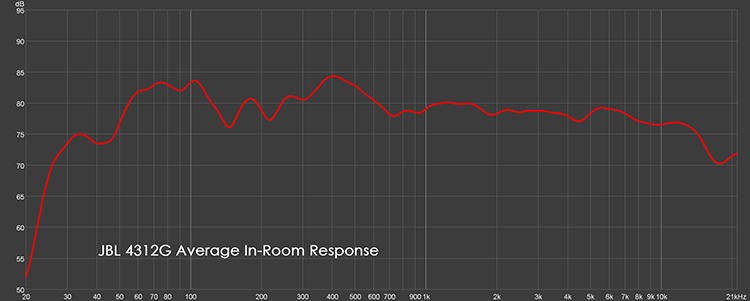
The in-room measurement is an 18-point spatial average. A 9-point measurement was made for the right speaker and then repeated for the left speaker. Averaging both speakers is an approach others have been using and publishing. Using data from both speakers reduces the modal response of the room by averaging the differences in the response of the two speakers from room asymmetries. The technique cannot eliminate them and the response below 300Hz remains room dominated. The results show a nicely controlled response from 700 Hz to about 14 kHz where the tweeter begins to roll off in-room. Below the 640 Hz crossover point, where the woofer takes over, the response increasingly becomes more room-dominated. The 6 dB hump centered at 400Hz could account for some of the perceived vocal prominences that I was hearing from these speakers. The response dips at 160 Hz and 220 Hz are room artifacts that show up in pretty much all my measurements in this room. Bass response is solid down to about 55 Hz before rolling off.
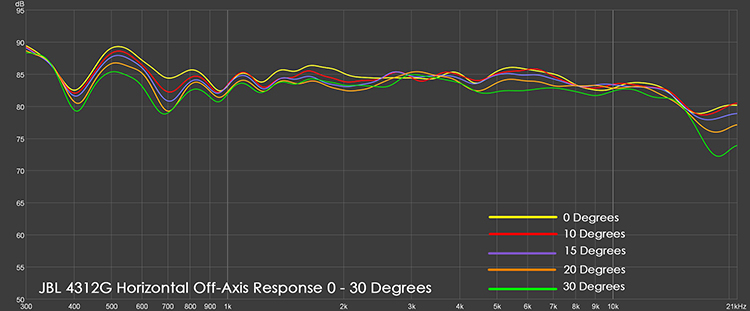
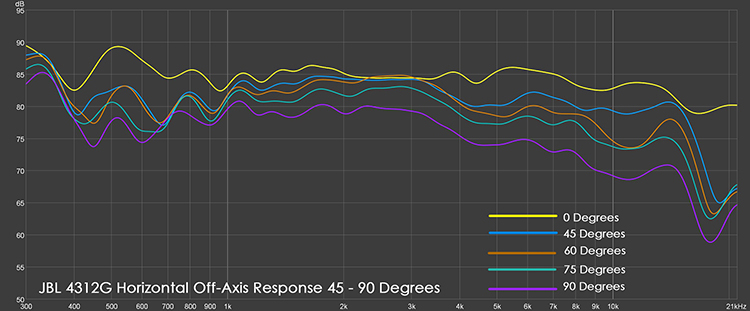
Above are the horizontal radiation curves of the 4312G from 0 to +30 degrees and +45 to +90 degrees. These were taken with the speaker set up horizontally, as I listened to them, with the microphone moving progressively away from the woofer. While these traces look fairly tightly matched, they are not as well controlled as the Revel F228Be I had here previously. And due to the off-set arrangement of the drivers, the radiation curves from 0 to -30 degrees (opposite side) would not match these as ideally they would in a speaker that had even, vertically arrayed drivers. This is why, with the speakers on their sides and the tweeter/midrange drivers positioned on the inside for listening, the imaging was very good and precise when sitting in the sweet spot but dropped off noticeably when sitting off-axis.
When closely examining the on and off-axis measurements, we see the graphs begin to converge at 1kHz. The specified midrange crossover of the 4312G is 640Hz. In his classic AES papers written while he was at the NRC in Canada, Dr. Floyd Toole observed that the off-axis response should be monotonic in the speaker dominated response (above 300Hz) as a requirement for good sound (see: “Loudspeaker Measurements and Their Relationship to Listener Preferences Part 1”, Journal of the Audio Engineering Society Vol. 34, No. 4 April, “1986, “Part 2”- Journal of the Audio Engineering Society Vol. 34, No. 5 May, “1986 ).
Here non-monotonic behavior is smack in the midrange. It happens as the 12-inch woofer becomes directional below the crossover, while above the crossover the midrange is much less directional bringing the response closer to 0dB.
Non-monotonic behavior is also seen at the tweeter crossover (5kHz). Here the midrange is getting directional before the crossover then, after the crossover, the dome’s wide dispersion moves the graphs back towards 0 dB. A more modern-day equivalent 3-way bookshelf pro speaker for comparison would be the JBL Pro LSR 6332. It has a woofer to midrange crossover at 250Hz.
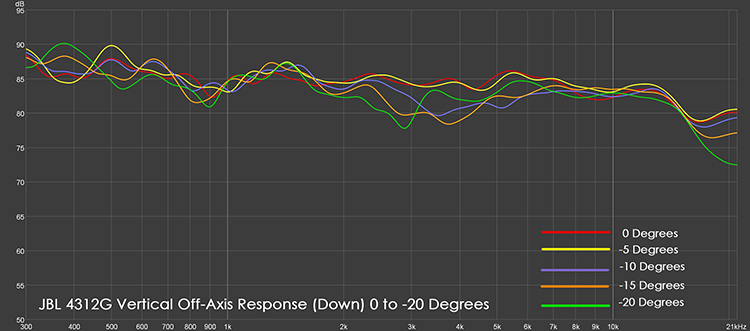
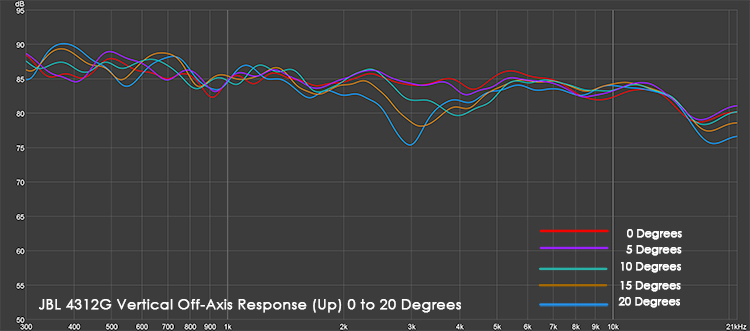
Moving to the vertical radiation pattern for positive and negative angles, we see the plots for 0 to -20 degrees and 0 to +20 degrees. Again, these aren’t as controlled as what I measured with the Revels and no doubt are a result of the off-set drivers. Not bad but not ideal either.
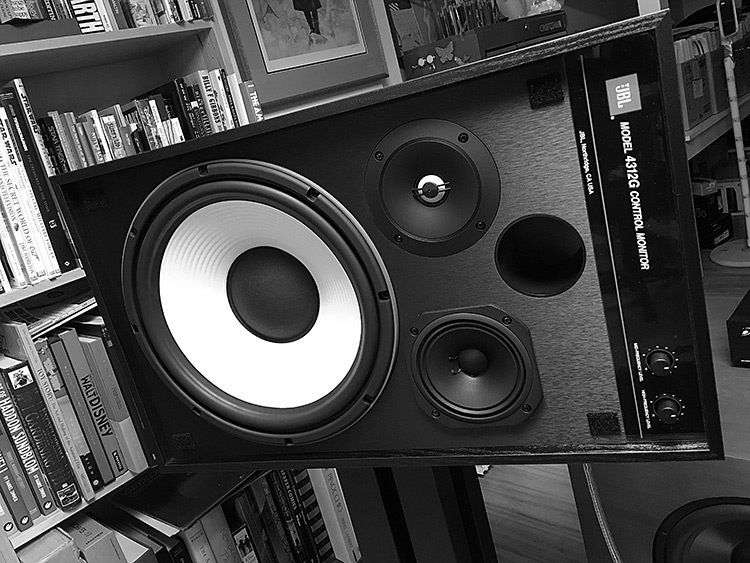
Capable and retro-cool, the JBL 4312G brings me back to why I got into this hobby.
- Classic design and retro monitor look.
- Great overall sound with good imaging in the sweet spot.
- Front-mounted High and Mid Trim controls are handy.
- Makes less-than-stellar recordings sound good.
- Better off-axis performance.
- Brown walnut option
The JBL 4312G is an interesting animal in many respects. It is based on the design, and styling, of a classic JBL studio monitor yet, by using modern technology and know-how, it most certainly sounds better than the progenitor speaker ever could. The mirror-imaged design allows for horizontal as well as vertical placement should you wish to experiment. By modern standards, it is a good sounding speaker. If you are looking for the best pair of speakers that $2500.00 can buy then the 4312G, frankly, faces some very stiff competition. Some surely may do certain things better and measure better than these do. But with all that being said, I believe these speakers are aimed at a more targeted crowd. They play heavy on the nostalgia card and appeal to someone who wants good sound but with the classic design that evokes a different time and place. There are a lot of people who fit that category and I bet they would find these speakers to be a compelling purchase. If that sounds like you, then these speakers would be well worth your time to audition. They make a fine pair of rose-colored-glasses to hear the world through.
The author would like to thank David A. Rich for his assistance in this review.


